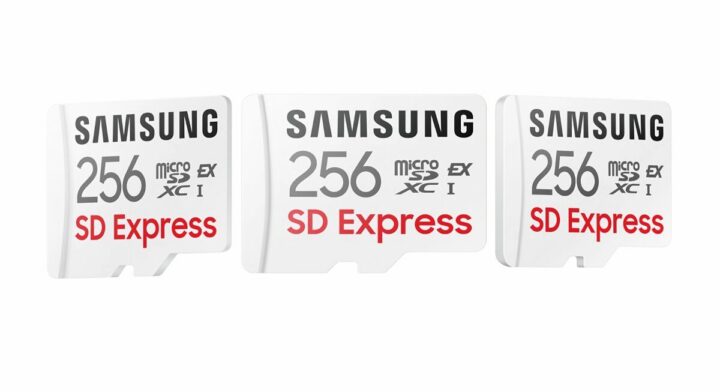Samsung has just started sampling its 256 GB SD Express microSD card (aka microSD Express card) with a sequential read speed of up to 800 MB/s through its PCIe/NVMe interface.
The SD Express standard was first introduced in the SD specification ver 7.0 in 2018 adding pads for PCIe/NVMe interfaces in full-sized SD cards before the microSD Express standard was introduced in the SD 7.1 specification the following year. Since then, the SD association further improved the standard promising ever faster SD Express speeds up to 4GB/s and microSD Express speeds up to 2GB/s.
Saying the adoption of the new SD Express and microSD Express standards has been slow would be an understatement, and the Samsung 256GB microSD Express card looks to be the world’s first such storage device. Looking at full-size SD Express cards, I could only find one on Amazon for $59.99 with 256GB capacity, 820 MB/s read speed, and 500 MB/s write speed. It also ships with an SD Express card reader simply because I’m not aware of any devices supporting the new standard… At least those cards are backward compatible so they’ll work on any SD card/microSD card reader but at a slower speed, for example up to 104MB/s with a UHS-I card reader. ADATA also offers two models with 256GB or 512GB capacities at higher prices.
Besides the chicken and egg issue of launching a new storage standard, those microSD Express can get very hot, and Samsung claims its Dynamic Thermal Guard (DTG) technology helps maintain the optimum temperature for the SD Express microSD card even when they are used for a long period of time. Performance-wise, 800MB/s is four times faster than the best UHS-1 memory cards and 1.4 times faster than recent SATA SSDs capable of up to 560 MB/s transfer rates.
Samsung says the 256GB SD Express microSD card will be available for purchase later this year, but did not provide pricing information at this time. The company did say it was developed in collaboration with a customer so we can expect a consumer device such as a smartphone or laptop with an integrated microSD Express reader around the same time.
Via Liliputing

Jean-Luc started CNX Software in 2010 as a part-time endeavor, before quitting his job as a software engineering manager, and starting to write daily news, and reviews full time later in 2011.
Support CNX Software! Donate via cryptocurrencies, become a Patron on Patreon, or purchase goods on Amazon or Aliexpress





